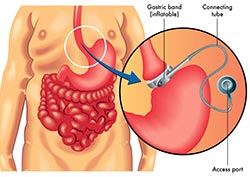
Bariatric Surgical Procedures (Weight-Loss Surgery)
Bariatric surgical procedures help you achieve your weight-loss goals and reduce your risk of experiencing medical issues caused by obesity. There are two principle ways that bariatric surgery drives weight loss:
- Restriction - The physical amount of food held by the stomach is limited, along with the calories.
- Malabsorption - The number of calories and amount of nutrients absorbed by the body is reduced by shortening, or bypassing, the small intestine.
Types of Bariatric Surgery Performed

There are four different types of bariatric surgical procedures performed: sleeve gastrectomy, biliopancreatic diversion with duodenal switch, roux-en-Y gastric bypass and laparoscopic adjustable gastric banding.
Sleeve gastrectomy
During a sleeve gastrectomy, the surgeon separates a portion of the stomach and removes it from the body. A tube-like structure is then formed from what remains of the stomach. The stomach is now smaller in size and can hold less food than before. You may notice that you have less of a desire to eat because the hormone gherkin is released, which regulates your appetite. The absorption of calories and nutrients in the intestines, however, is not affected by a sleeve gastrectomy.
| Sleeve gastrectomy package | Price $ |
|
The Package Includes: * Up to 4 days of hospitalization. * Surgery operating room charges: operating room, recovery room, scrub & circulating nurse * Routine laboratory tests necessary for the procedure as ordered by the attending physician. * Radiology Studies: Chest X-ray. * Medications: Routine medication used for procedure, during admission only. * Equipment costs: Medical Supplies, Routine Surgery Supplies. * Doctor Fees: Surgeon + Anesthesiologist + Assistant Surgeon (if necessary) |
19,460 - 21,500 |
Biliopancreatic diversion with duodenal switch
Similar to a sleeve gastrectomy, the surgeon starts a biliopancreatic diversion with duodenal switch by removing a sizable portion of the stomach. The valve that releases food to the small intestine remains, as well as the first part of the small intestine, called the duodenum. The middle portion of the intestine is then closed off and the surgeon attaches the lower portion directly to the duodenum to complete the duodenal switch.
Instead of removing the separated part of the intestine from the body, the surgeon reattaches it to the bottom of the intestine to complete the billopancreatic diversion. This allows pancreatic digestive fluids and bile to reach this portion of the intestine. Because food will now bypass much of the small intestine, absorption of nutrients and calories is limited. Combined with a reduction in stomach size, the patient experiences weight loss.
Roux-en-Y gastric bypass
During a type of bariatric surgery known as a Roux-en-Y gastric bypass, a small pouch is created by the surgeon in the upper part of your stomach. The surgeon then cuts the small intestine just below the stomach and connects it to the newly created pouch to so that food can freely flow from the pouch to this section of the intestine. Because this pouch will be the only only portion of the stomach that can absorb food, the amount you can drink or eat in comfort at a given time is highly limited.
There are still digestive fluids being made by the primary part of the stomach. The surgeon relocates the part of the intestine that remains adhered to the stomach to let these digestive fluids reach the small intestine. When this section of the small intestine is bypassed, your caloric and nutrient intake is limited.
| Gastric Bypass package | Price $ |
|
The Package Includes: * Up to 4 days of hospitalization. * Surgery operating room charges: operating room, recovery room, scrub & circulating nurse * Routine laboratory tests necessary for the procedure as ordered by the attending physician. * Radiology Studies: Chest X-ray. * Medications: Routine medication used for procedure, during admission only. * Equipment costs: Medical Supplies, Routine Surgery Supplies. * Doctor Fees: Surgeon + Anesthesiologist + Assistant Surgeon (if necessary) |
23,150 - 25,500 |
Laparoscopic adjustable gastric banding
During a laparoscopic adjustable gastric banding procedure, the surgeon places a band with an inflatable balloon around the top portion of the stomach and affixes it in place. There is now a small pouch in the stomach, leaving an extremely narrow channel to reach the remaining stomach.
The surgeon then places a port under the skin of the abdomen and connects it to the band with a tube. The size of the band can be adjusted by adding or removing fluid through the port. to either inflate or deflate the balloon. Gastric banding limits the amount of food your stomach can hold to create the feeling of “being full”, but nutrients and calories are still fully absorbed.
Leading department specialists









